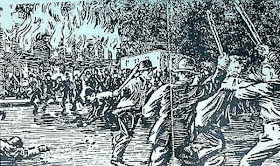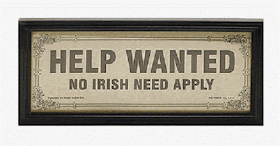I think of him as one of those self-made right-wing technocrats, who used his fortune to finance an ultra-conservative agenda - a Ross Perot or the Koch family. In this case the technology was the telegraph, and the agenda was the 19th century version of Islamaphobia. Samuel Finley Breese Morse (above) learned to fear the 'Bavarian Illuminati' from his minister father's Sunday sermons. As an adult Samuel proselytized that the Roman Catholic Church was flooding America with Irish and German Catholic immigrants to establish a new Vatican City in the Mississippi valley. Wrote Morse, “Surely American Protestants...(will) discover...the cloven foot of this subtle foreign heresy. They will see that Popery is...a political as well as a religious system; that...differs totally...from all other forms of religion in the country.” In 1836 Morse ran for Mayor of New York City. He lost big. But the poison he was peddling (and funding) would take root.
It sprouted into full flower in the congressional elections of 1854, catching on “like measles”, according to one Democrat. The organization was officially known as “The American Party”, but commonly refereed to as the Know Nothings, because its members were coached to respond to all questions by admitting only, “I don't know”, and because, frankly, in the eyes of their critics, they just seemed to be not very bright. Membership was limited to white males of proven English heritage, and usually evangelical Protestants,. And although most of the new candidates had never been active in politics or held public office before, they won 61 seats in the U.S. House of Representatives. They elected a governor and all the other posts open that year in Massachusetts and Maine. They controlled the state legislatures in Pennsylvania and most of New England. They gained advantage in Maryland, Delaware, Kentucky and Tennessee by taking no position on slavery. This hurt them in the south, as did violence and murders in Chicago, Philadelphia, Baltimore, St. Louis, Boston, New York, Columbus, Cincinnati and New Orleans. Still, the Know Nothings looked certain to capture the White House in 1856. And then came Bloody Monday in Louisville, Kentucky.
They held three elections in Louisville in 1855. On April 7th, voters threw out the incumbent mayor, who had converted to Catholicism, and elected a Know Nothing replacement and a majority on the city council. They followed this a month later by electing a Know Nothing majority of county court judges. Then the school board fired every Catholic teacher, save one. The Know Nothings were feeling both confident and paranoid - it was the nature of the party and the movement. Now another Know Nothing, Charles Morehead, was favored to win the governorship on yet another election, Monday August 6th. On the night before, 1,500 Know Nothings staged a torch light march through Catholic neighborhoods, warning them “to keep their elbows in” come morning.
Maybe no one other than Reuben Thomas Durrett (above) could have made the nation face the truth about the Know Nothings. Others wrote about it, but they lacked his resume. R.T., as he preferred to be known, was a defense attorney, and familiar with arguing unpopular causes. He was “intellectually and physically...a magnificent man.” More than that he was a poet, and a lover of truth and history. He had a 50,000 volume personal library. And 300 years earlier, his French Protestant ancestors had barely escaped the St. Bartholomew's Day massacre in France. So when the political spin machine tried to smother every honest voice in Louisville, it was R.T. who validated the reality. “To my mind,” he wrote, “the whole secret of the success of this disgraceful affair was...that the Know Nothing sympathizers were prepared and armed for the conflict...”
According to R.T., the thugs, hired as “special police”, formed a gauntlet in front of the polls. If a would-be voter were an immigrant from Germany or Ireland he was presumed to be Catholic, and was “... ordered by one of the bullies to leave...” And if he refused, “...he was attacked by the whole mob, severely beaten and driven away. If the man showed fight, his life was in great danger. “ Recently ousted Mayor James Speed watched the beatings on the courthouse front lawn from eight in the morning until six. “It was not fighting man to man, but as many as could fall upon a single Irishman or German and beat him with sticks or short clubs...” The clubs were specially made with lead weights in their tips, and mass produced. In the afternoon Speed was told 200 shotgun wielding “Germans” had captured a polling place. Speed knew this to be a fantasy and said so. But the informant, a judge, “replied with warmth showing that he believed it to be true.” About four in the afternoon, things went from bad to worse.
Two Catholic activists, Theodore Rhodes and David Doughtery were warning everyone in their east side neighborhood off Main Street. They stopped at Micheal O'Connor's grocery store, at the corner of 10th street and warned him to close. As they came out of the store a man ran up to them. Basil Rhodes, Theodore's father, who lived a block away, saw the man shoot his son dead. The gun shot drew Know Nothings from all directions, and it quickly became common knowledge that the reverse was true, that a Catholic had killed a Know Nothing. What followed was wholesale murder.
The worst of it was Quinn's Row, a block of 12 three story row houses along Main between 11th and 12th streets. Around eight that evening a Know Nothing mob set fire to a ground floor corner grocery run by a family named Long. Recorded a Catholic newspaper, “Seeking to escape...the wretched inhabitants reached the street only to meet death in another form. As soon as one appeared at a door he was fired at...” Mr. Long and two of his sons died that night, as did several of the residents of the upper floor apartments. “A number were taken off badly wounded, and others...returned to the burning houses, preferring rather to be burned than to meet the infuriated mob. One man escaped in woman’s clothes, was detected and shot. Another, who came out covered with a blanket, and, leaning on the arm of his wife, was torn away, and deliberately shot.”
While the first building was still raging, the feed store next door and its apartments went up, followed by a vacant house, then a tobacconist. Noted the newspaper, “How many of these miserable people thus caged in their own houses were burned alive there can be no computation.... Two men were hanged from their banisters of their own homes and also consumed in the flames.” In the last structure on the street, a rooming house, Patrick Quinn, who owned the entire block, was driven outside like the others. Recognized because of his investments around the city (and his brother who was a priest) , he was singled out, beaten to death, and his corpse was thrown back into the fire.
The official version said that 22 people had been killed in the entire city on Bloody Monday It is much more likely that the number was at least 100. The death toll would have been higher but in the German district one of the first buildings looted was Armbruster's brewery. The rioters got so drunk they could only satisfy themselves with torching the building before passing out. The new Know Nothing Mayor, John Barbee, managed to save two Catholic Churches from the rioters, but no one was ever prosecuted for the murders, the beatings or the arson. In response the despised immigrants voted with their feet. Ten thousand left Louisville over the next few months, almost 25% of the cities' population. In the city left behind businesses failed, unemployment soared and city coffers dried up. Charles Morehead was easily elected governor. but it was the classic tale of “be careful what you wish for”.
Most of the Irish moved to Chicago. Typical was ex-Mayor Speed, who became active in Republican Party politics and served in the Lincoln administration. The Germans mostly moved to St. Louis and Milwaukee, and some to Kansas City, Kansas – ensuring that state would remain in the Union come the Civil War. It was that war which put the entire Know Nothing movement into perspective.
The Civil War made the Know Nothing agenda obsolete. Immigration was the great enemy in the eyes of Samuel Morse. But the actual cause of the war was the industrial revolution, and the refusal of one half of the nation to recognize mechanization was making human slavery obsolete. The mathematician Alfred Whitehead observed, “The major advances in civilization....all but wreck the societies in which they occur.” And in his book “War and Peace in the Global Village” Marshall McLuhan explains why that is so. “When one has been hurt by a new technology, when the private person or corporate body finds its entire identity endangered...it lashes back in a fury of self-defense...But... the symptom against which we lash out may be caused by something about which we know nothing.” McLuhan calls that symptom “Phantom Pain”, and compares it to the agony amputees report they feel in missing limbs.
Although America has institutionalized such cultural revolutions, and has succeeded by taking advantage of them in the past, that does not make our politics, and did not make the politics of our ancestors, any easier to live with. Politics are never a solution. Politics are only another symptom.
- 30 -













No comments:
Post a Comment
Please share your reaction.